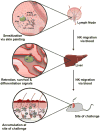Adaptive immune responses mediated by natural killer cells
- PMID: 20536570
- PMCID: PMC2911633
- DOI: 10.1111/j.0105-2896.2010.00906.x
Adaptive immune responses mediated by natural killer cells
Abstract
Adaptive immunity has traditionally been considered a unique feature of vertebrate physiology. Unlike innate immune responses, which remain essentially unchanged upon exposure to a recurrent challenge with the same stimulus, adaptive immune cells possess the ability to learn and remember. Thus, secondary adaptive responses to a previously encountered challenge are qualitatively and/or quantitatively distinct from those elicited by a primary encounter. Besides this capacity to acquire long-lived memory, the second cardinal feature of adaptive immunity is antigen specificity. It has been generally believed that only T and B cells can develop antigen-specific immunologic memory, because these lymphocytes uniquely express recombination-activating gene (RAG) proteins, which are necessary for somatic rearrangement of V(D)J gene segments to assemble diverse antigen-specific receptors. However, recent work has uncovered discrete subsets of murine natural killer (NK) cells capable of mediating long-lived, antigen-specific recall responses to a variety of hapten-based contact sensitizers. These NK cells appear to use distinct, RAG-independent mechanisms to generate antigen specificity. Murine NK cells have also recently been shown to develop memory upon viral infection. Here, we review recent evidence indicating that at least some NK cells are capable of mediating what appears to be adaptive immunity and discuss potential mechanisms that may contribute to RAG-independent generation of antigenic diversity and longevity.
Figures


References
-
- Janeway CA, Jr, Medzhitov R. Innate immune recognition. Annu Rev Immunol. 2002;20:197–216. - PubMed
-
- Bassing CH, Swat W, Alt FW. The mechanism and regulation of chromosomal V(D)J recombination. Cell. 2002;109 (Suppl):S45–55. - PubMed
-
- Cooper MD, Alder MN. The evolution of adaptive immune systems. Cell. 2006;124:815–822. - PubMed
-
- Lanier LL. NK cell recognition. Annu Rev Immunol. 2005;23:225–274. - PubMed
Publication types
MeSH terms
Substances
Grants and funding
LinkOut - more resources
Full Text Sources
Other Literature Sources

